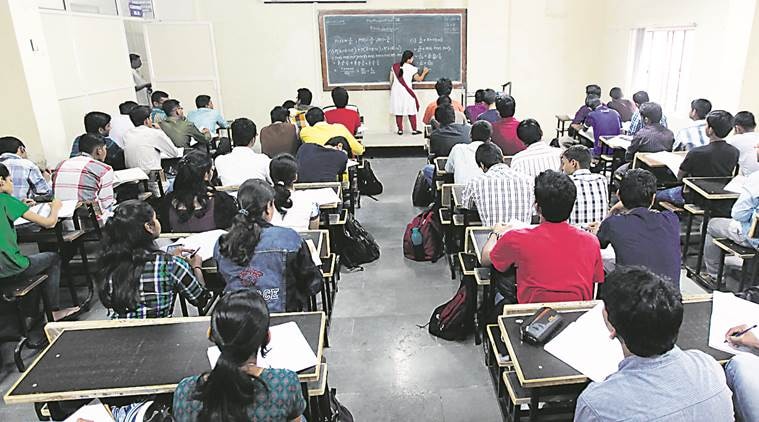Stay updated with the latest - Click here to follow us on Instagram
From starting digital classrooms to teaching inside a container and on the streets
In Kandivali a 23-year-old chartered accountant has a reputation that precedes him. For six years now, Prince Tiwari has been teaching children living on the streets, giving up his CA dreams in the process.
 Teacher teaching in classroom. File photo
Teacher teaching in classroom. File photo
(Written by Ammar Zaidi)
Exactly two years ago, the Urdu school number 6 of M-East Ward in Shivaji Nagar, Govandi, became the first municipal school with a ‘digital classroom’. The classroom was started on an experimental basis by Mohammed Zeeshan, a teacher in the school, but soon became a hit and was emulated in other BMC schools soon after.
Zeeshan had joined as a teacher in the BMC in 2011 and as soon as he joined the Govandi school he realised that dropout rates were high in the school. So, instead of just signing the muster and doing the job like any other teacher, he decided to try an experiment to keep the children from dropping out.
“I resorted to an innovative and animated version of the textbook stories, picking up from online videos on digital classrooms,” Zeeshan recalled. “It became a hit with the children. So I decided to take it up a notch by introducing power point presentations and audio-visual clips for Class VI students,” he said.
The bigger challenge was to adapt the text-heavy syllabus to digital teaching techniques. “But soon other teachers joined in and we started preparing our own presentations and curating videos we could show on phone,” he said. There was no projector in the school at this point and it was then that Zeeshan sought a projector from the BMC.
Today, the classroom has a projector, a screen and is equipped with audio system. The poems taught are not just verses but are set with music. His students visit a blog set up by him where everything is a quiz: Kaun Banega Gyaanpati.
“If the students need a recap, there are YouTube lessons for them. The classroom has touchscreen projector boards with sound systems. The children really look forward to working with the teachers,” he said. So impressed were BMC officials that the classroom was later emulated in many other municipal schools across the city.
In the past two years, the Signal School in Thane, too, has touched many milestones, including its first batch of SSC graduates.
Bhatu Sawant, administrator of the school, said that the school has lit up the lives of 43 children begging and selling stuff below the Teen Hath Naka bridge in Thane, all thanks to its teachers who learnt the tribal languages spoken by the children were comfortable with.
With the help of the Thane Municipal Corporation, Bhatu Sawant’s Samarth Bharat Vyaspeeth started teaching the children inside an air-conditioned container below the bridge.
The teachers were not purloined from the TMC schools but were from Samarth Bharat Vyaspeeth. Teachers Arti Parab and Shraddha Dandawate learnt the languages of the tribal children to teach them Marathi and Hindi.
“When we started teaching, we realised that the children didn’t know Hindi, English or Marathi. So it was difficult to communicate with the children and explain the concepts. It was then that we decided to learn the language and train the children in their mother-tongue,” said Parab.
The idea was mooted by the TMC when they thought these children should be assimilated into mainstream education. Bhatu Sawant told them that there was no way the parents would actually come to a municipal school everyday and then drop them off. Initially the children were taught for only two hours as they had very little discipline and patience. Now they spend over eight hours everyday in their container and the signal school is all set to get its second container. The children have even got their own lockers and their school uniforms are washed by an ayah appointed by the NGO. They have got an Aadhaar card and identity and when they fall sick they are taken for treatment to doctors which never happened before.
In Kandivali a 23-year-old chartered accountant has a reputation that precedes him. For six years now, Prince Tiwari has been teaching children living on the streets, giving up his CA dreams in the process.
Tiwari started as a teacher, when he was himself a 17-year-old accounts student at Thakur College. He had chanced upon some children while walking out of a temple and had decided to teach them in his spare time.
Often taking classes on the roadsides, near the children’s homes, Tiwari came to be known as the roadside teacher. Soon, attendance at his classes started to swell. “Most of these children went to BMC schools but were not regular in their studies. Their parents were sweepers and used-cloth buyers,” said Tiwari.
When the number of children increased to 96, more helped poured in and the children are now enrolled at the Thakur Shyamnarayan High School. Tiwari has since started his own NGO, Teresa, Ocean of Humanity Foundation.







